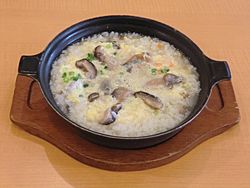Zosui facts for kids

Mushroom zosui
|
|
| Alternative names | Ojiya |
|---|---|
| Type | Soup |
| Place of origin | Japan |
| Main ingredients | Rice, water |
Zōsui (雑炊, literally "miscellaneous cooking"), also called ojiya (おじや), is a light Japanese rice soup. It is like a vegetable soup but uses rice as a main ingredient.
To make zōsui, pre-cooked rice is used. It is cooked in dashi (a type of Japanese broth) or water. The soup is flavored with either soy sauce or miso. Other ingredients like meat, seafood, mushrooms, and vegetables are often added. Zōsui is usually served to people who are sick or not feeling well. It is also a popular dish in the winter.
Sometimes, leftover soup from a nabe (Japanese hot pot) is used to make zōsui. Instead of rice, some people now use udon or ramen noodles.
History of Zōsui
Long ago, it was hard to keep cooked rice warm. People would mix cold, leftover rice with miso soup to reuse it. This was a common practice in homes across Japan.
Today, zōsui is more often made for people who are sick. It is not as common for everyday meals anymore.
Types of Zōsui
There are many different kinds of zōsui. Here are a few examples:
- Maru zōsui (まる雑炊): Made with Chinese softshell turtle.
- Fugu zōsui (ふぐ雑炊): Made with pufferfish.
- Tori zōsui (とり雑炊): Made with chicken.
- Kani zōsui (かに雑炊): Made with crab.
- Sukiyaki zōsui (すきやき雑炊): Uses flavors from sukiyaki.
- Shabu-shabu zōsui (しゃぶしゃぶ雑炊): Uses flavors from shabu-shabu.
When people make zōsui at home, they often use leftover broth and rice. They add whatever ingredients they have on hand.
Ojiya: A Similar Dish
The word ojiya often means the same thing as zōsui. The word ojiya came from the nyōbō kotoba, which was a special language used by court ladies long ago. No one is sure where the word came from. It might be from the sound rice makes when it cooks. Or it could be from olla, a Spanish word for a cooking pot.
Many people use ojiya and zōsui to mean the same dish. How they are used can depend on the region or family. However, there are some common differences:
- Rice preparation: For zōsui, the rice is often rinsed first. This makes it stickier. For ojiya, the rice is usually not rinsed.
- Rice shape: In zōsui, the rice grains tend to keep their shape when cooked. In ojiya, the rice grains often break apart and become softer.
- Broth color: Zōsui broth is usually flavored with soy sauce, which gives it a darker color. Ojiya broth can be flavored with miso or soy sauce, but it often stays lighter in color.
Jūshī: The Okinawan Version
Jūshī (ジューシー) is a dish from Okinawan cuisine. It is thought to be a type of zōsui. However, jūshī is usually made with uncooked rice. It also uses much more water than zōsui. This is why it is called jūshī, which means "juicy."
There are two main types of jūshī:
- Kufajūshī (クファジューシー) (or katai jūshī (固いジューシー, literally "firm jūshī")): This is a firmer rice dish.
- Yafarā jūshī (ヤファラージューシー) (or yawarakai jūshī (柔らかいジューシー, lit. "soft jūshī")): This is a softer, more soup-like version, similar to zōsui.
Many different ingredients can be used in jūshī. These include lard or margarine, ribs, hijiki (seaweed), carrots, shiitake mushrooms, and konjac jelly. Yafarā jūshī often has ribs or pork, yomogi leaves (フーチバー, fūchibā), potato leaves (カンダバー, kandabā), and taro (チンヌク, chinnuku).
See also
 In Spanish: Zosui para niños
In Spanish: Zosui para niños

